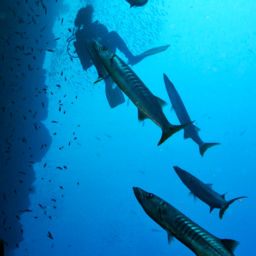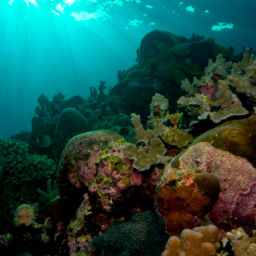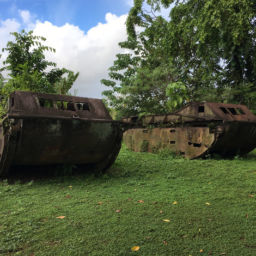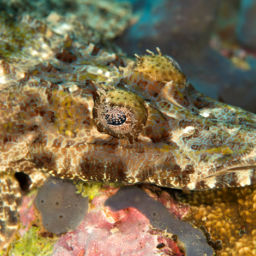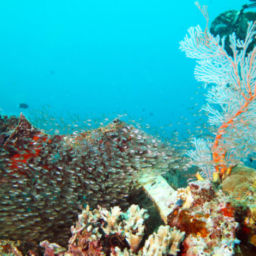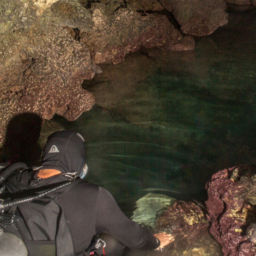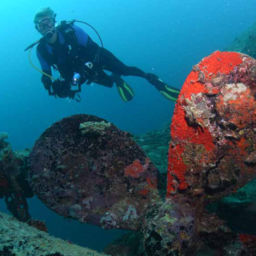World War II battles engulfed much of the Solomon Islands from 1942 to 1945, leaving behind evidence of these fights both topside and underwater. On a recent visit to the islands of Gizo and Munda in the remote Western Province, this history came alive.
Visiting Gizo
Tiny Gizo and much larger New Georgia are both musts for World War II buffs, and the highlight of a visit to Gizo is a stop at Kennedy Island. On August 1, 1943, PT-109 set off on an ill-fated night patrol from Rendova, looking for Japanese targets in the area. At around 2:30 am on the 2nd, the Japanese destroyer Amangiri rammed the patrol boat. The attack cut the PT boat in half and killed two of the 13 crewmen. In command of the boat that night was a young John F. Kennedy, only 24 years old. He was uninjured and ready to prove himself a leader.
Two of his fellow crewmen were injured and Kennedy towed one of them to safety on Kasolo Island. Kennedy accomplished this swim of over three miles by clenching the man’s life-vest strap in his teeth, leaving his own arms free for swimming. Tiny Kasolo, now known as Kennedy Island, would be the crew’s home base for the next few days. Kennedy and his crew members made swimming forays to nearby islands, hoping to find fresh water and a closer location to Ferguson Passage, through which American PT boats passed.
On August 5, Kennedy encountered two Solomon islanders, first on Naru Island, then on nearby Olasana Island, where he’d left his crew. The two men, Biuku Gasa and Eroni Kumana, were islander scouts for the Allies. Kennedy’s crew on Olasana finally convinced them that the stranded men were American. On August 6, after Kennedy scratched a message asking for help into the husk of a green coconut, Gasa and Kumana left with it in search of assistance. Finally, on August 8, the surviving crew of PT-109 was rescued under Kennedy’s direction.
Visitors to Kennedy Island today will find the same small outpost. There’s a small bar and shelter on the island, which is just across the bay from Fatboys resort (see below).
Visiting New Georgia
Munda, the largest town on New Georgia, is only a 5-minute flight away from Gizo. When you arrive, you’ll land on a recently upgraded airstrip, but history is never far away. This modern runway sits on the same site as the Japanese airstrip that occupied the space during WWII, much coveted by the Allies. Because of the airstrip, Munda was the Japanese base on New Georgia. After wresting the base and airstrip from the Japanese on June 30, 1943, both sides left behind a treasure trove of war materiel. To see the most topside, there are two can’t-miss activities in Munda: a visit to the Peter Joseph Museum and a ride in (or at least a look at) a fully restored WWII jeep.
The Peter Joseph Museum
To get to the museum, you’ll drive out of the center of town through the country, eventually turning down a rutted track in the bush past the local soccer field. Ditch any preconception of what a museum entails before you arrive at the roughly 20-by-20-foot open-air shed, absolutely crammed full of artifacts from WWII, many of them seemingly in working order. You’ll meet Alphy B. Paulsen, proprietor of the museum and an island native with a passion for collecting abandoned WWII artifacts and meticulously cataloging and cleaning them. The museum sits on his property and he named it for the first set of dog tags he found here, belonging to one Peter Joseph. There are three long tables, running the length of the shed, absolutely groaning under the weight of the artifacts piled atop.
You’ll see Japanese and American machine guns, grenades, knives, sake bottles, and Coke bottles. There are canteens, helmets, rounds of ammunition, Browning automatic machine guns, a howitzer, an engine and eyeglasses. Don’t miss the mess tins, unopened vials of morphine and first aid kits. There are hundreds of dog tags as well — and all this is not even a portion of what he’s found. And best of all, guests can touch or pick up anything they want, as long as they’re careful with it.
Before he became a collector, Paulsen and his friends would strip much of the WWII memorabilia they found on the island for scrap metal and sell it, but since he began this enterprise, he’s gotten the island’s youth looking for items he can add to his collection. He says nowadays they use metal detectors to find artifacts, but that there’s plenty still out there.
In the 1970s, he and his friends found a case of Coke dating from the war at the town dump, unopened and with bottles still sealed with wax — so they drank it. “We shook a bottle and it was still fizzy, so we tried it,” he says. “After we drank it, we just kind of waited around to see what would happen to us.”
Take your time and walk slowly through the room. Paulsen is an eager guide, who can tell you the history of every item you pick up. Although he generally keeps the museum open from around 6 a.m. to 6 p.m., have your hotel call ahead. You’ll likely get a ride from someone at the hotel either way, because it’s a bit of a trek. Even for those with only a passing interest in war history, the museum is well worth a look. The sheer volume of memorabilia, as well as Paulsen’s enthusiasm, will leave a lasting impression.
Ride in a WWII jeep
Your next visit in Munda must be another lovingly tended pet project — a fully restored WWII jeep constructed by local man Alfie Rex Lai. After the battle at Guadalcanal, Alife’s grandfather began collecting discarded items from the war. The jeep passed then to his father and finally to Alfie. “I decided to restore it properly,” he said. “They had just been cobbling it together to drive it. The project took nearly 10 years, and he did all the mechanicals himself. The 1942 Willys Ford can reach 60 miles per hour, but it was designed for hauling gear, not for speed. “I didn’t want to modify the engine, says Alfie. “I wanted it to be original, with the original sound.”
For an island tour in the open-air jeep, including a visit to a pair of anti-aircraft Japanese guns buried deep in the jungle, ask at your hotel to be put in touch with Alfie — they’ll know who you mean.
To see some war history underwater, Dive Munda at the Agnes Gateway Hotel, offers around 10 nearby sites. These include the Kashi Maru, a Japanese freighter sunk by U.S. Air Force bombers in 1943. It lies in 55 feet (17 m) around 45 minutes via boat from Munda, and the artifact-filled hold is easily accessible. The dive shop also visits lots of nearby reefs.
Getting There
To get to Gizo and Munda you’ll have to fly through Honiara on Solomon Airlines. Flights do not depart every day, so check the website for details.
Staying in Gizo
If you’re looking for an idyllic island paradise, you won’t do better than Fatboys Resort. This secluded retreat occupies a tiny sliver of land on Mbabanga Island, just a short boat ride from Gizo proper. Simple bungalows feature thatched roofs, wide, ocean-front verandas and slowly circulating ceiling fans to keep the hot tropical air moving. At the end of the jetty you’ll find a friendly bar and restaurant, and from that vantage point you can clearly see Kennedy Island just across the bay. And as a bonus, there’s some pretty great diving nearby too — check with Dive Gizo.
Staying in Munda
Munda is the largest town on New Georgia, and home of the airstrip that you’ll use either one your way there or back to Guadalcanal. If you’ve come for diving or WWII history, the best home base is Agnes Gateway Hotel. Room choices range from simple backpacker bunks to private air-conditioned cottages with modern bathrooms, refrigerators and seating areas. The hotel also features the town’s best restaurant and onsite dive shop Dive Munda.
For more about visiting the Solomon Islands, check here.


















